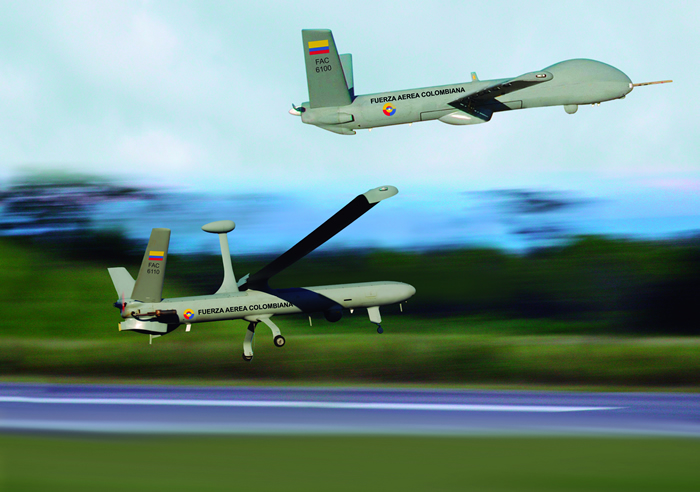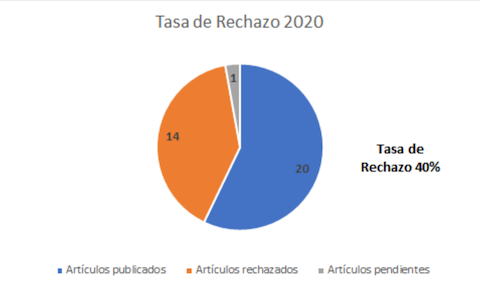De ficción a realidad: drones y seguridad ciudadana en América Latina
DOI:
https://doi.org/10.18667/cienciaypoderaereo.430Palabras clave:
ANT, América Latina, CCTV, drones, política pública, seguridadResumen
El uso de los drones en América Latina está confrontado a dos dilemas principales. Por un lado, no existe un marco normativo claro en muchos de los países. Por otro lado, las políticas públicas y los civiles hacen cada vez más uso de dicha herramienta, aumentando la necesidad de establecer limitaciones y condiciones para el empleo de estos aparatos. El exitoso uso de los drones en control y gestión de infraestructura o del territorio pone a debate sus beneficios y peligros. En este artículo se revisa en primer lugar, los contextos normativos latinoamericanos; segundo, se analizan los límites y debates ligados a la posible utilización de drones en las políticas de seguridad urbana latinoamericana, especialmente confrontándolos con las cámaras de vigilancia.
Descargas
Referencias
Allinson, J. (2015). The Necropolitics of Drones. International Political Sociology, 113-127.
https://doi.org/10.1111/ips.12086
Anderson, K. (2013). The Case for Drones. Proquest Social Sciences Journals, 14-23.
Arriaga, J. L. (2008). La Emergencia de la delincuencia organizada en un análisis genealógico de la tradición Nietzsche-Foucault. Revista Crítica de Ciencias Sociales y Jurídicas.
Balbridge, A. (2015). Commanding Heights . The Innovation Issue, 44-47.
Bamburry, D. (2015). Drones Designed for Product Delivery, 40-48.
https://doi.org/10.1097/01.NPR.0000469260.20991.54
Banco Interamericano de Desarrollo. (2012). Citizen Security Conceptual Framework and Empirical Evidence.
Banco Interamericano de Desarrollo. (2014). LAC2025 América Latina y el Cariben en 202. Banco Interamericano de Desarrollo.
Bardach, E. (2000). A practical guide for policy analysis: the eightfold path to more effective problem solving. California: Chatham House Publishers.
Barnard-Willis, D. (2011). UK News Media Discourses of Surveillance. The Sociological Quarterly, 548-567.
https://doi.org/10.1111/j.1533-8525.2011.01219.x
Berkowitz, R. (2014). Drones and the Question of The Human. Ethics and International Affairs, 159-169.
https://doi.org/10.1017/S0892679414000185
Berry, F. S., & Berry, W. D. (2014). Innovation and Diffusion Models in Policy Research. En P. A. Sabatier, & C. M. Weible, Theories of the Policy Process. (pp. 307-361). Colorado: Westview Press,.
Berry, W. (2015). A Pacifist Protest Against the Peaceful Drone. The Progressive, 29-32.
Bonner, M. D. (2008). Applying the Concept of "Human Security" in Latin America: An Argentine case study. Canadian Journal of Latin American and Caribbean Studies, 33(65), 7-31. doi:10.1080/08263663.2008.10816938
https://doi.org/10.1080/08263663.2008.10816938
Briceño, Y. M. (2009). Seguridad Ciudadana, Desempeño Policial y la Calidad de Vida en las Políticas Sociales. Revista Venezuela de Economía y Ciencias Sociales, 37-47.
Brooks, R. (2014). Drones and the International Rule of Law. Ethics and International Affairs, 83-103.
https://doi.org/10.1017/S0892679414000070
Bustamante, F. (2002). Los Limites de la Seguridad . Nueva Sociedad, 94-98.
Capolupo, A., & Pindozzi, S. (2015). Photogrammetry for Environmental Monitoring The Use of Drones and Hydrological Models for Detection of Soil Contaminated by Copper. Science of Total Environment, 298-306.
https://doi.org/10.1016/j.scitotenv.2015.01.109
Cargill, H. R. (2014). Reconnaissance Drones Their First Use in the Cold War. Air Power, 21-27.
Carrión, F. (2002). Seguridad Ciudadana, Espejismo o Realidad . Quito: FLACSO.
Clothier, Greer, Greer, & Meta. (2015). Risk Perception and the Public Acceptance of Drones. Risk Analysts, 1167-1183.
https://doi.org/10.1111/risa.12330
Cruz, J. M. (2011). Criminal violence and democratization in Central America: The survival of the violent state. Latin American Politics and Society, 53(4), 1-33. doi:10.1111/j.1548-2456.2011.00132.x
https://doi.org/10.1111/j.1548-2456.2011.00132.x
Cubillos, E. A. (2012). Ciudadanías en el límite. La Fotografia Participativa . Secretaría de Cultura, Recreación y Deporte de Bogotá, 41-57.
Degenhardt, T. (2015). Crime, Justice and the Legitimacy of Military Power in the International Sphere. Punishment and Society, 139-162.
https://doi.org/10.1177/1462474515577154
Desmond, E., & Ungar, M. (2013). La Vigilancia Comunitaria y la Crisis de Seguridad Ciudadana en Latinoamérica. Community Policing and Latin America's Citizen Security Crisis, 19-52.
Dubrofsky, R. E. (2011). Surveillance on Reality Television and Facebook . Communication Theory, 111-129.
https://doi.org/10.1111/j.1468-2885.2011.01378.x
Evans, R. (2015). The Footage is Decisive Applying the Thinking of Marshall McLuhan to CCTV and police Misconduct. Surveillance and Society, 218-232.
https://doi.org/10.24908/ss.v13i2.5298
Farr, A. J., Hacker, J. S., & Kazee, N. (04 November, 2006). The Policy Scientist of Democracy : The Discipline of Harold D. Lasswell. American Political Science Review, 100, 579-587.
https://doi.org/10.1017/S0003055406062459
Fitzpatrick, A. C. (2014). Drones For Good Technological Innovations, Social Movements, and The State. Journal of International Affairs, 19-36.
Flores-Macías, G. A. (2013). Financing Security Through Elite Taxation: The Case of Colombia's "Democratic Security Taxes." Studies in Comparative International Development, 477-500. doi:10.1007/s12116-013-9146-7
https://doi.org/10.1007/s12116-013-9146-7
Fruhling, D. H. (2012). La eficacia de las políticas públicas de seguridad ciudadana en América Latina y el Caribe Como medirla y como mejorarla. Banco Interamericano de Desarrollo.
Gabaldón, L. G. (2007). Seguridad Ciudadana, Confianza Pública y Policía en Venezuela. Revista Venezuela de Economía y Ciencias Sociales, 87-98.
Goold, B. (2006). Open to all Regulating Open Street CCTV and the Case for Symmetrical Surveillance. Criminal Justice Ethics, 3-17.
https://doi.org/10.1080/0731129X.2006.9992191
Gregory, D. (2011). From a View to a Kill Drones and Late Modern War. Theory, Culture and Society, 189-215.
https://doi.org/10.1177/0263276411423027
Hadyijanni, T. (2009). The Social Dimension of Security Exploring How Surveillance Systems Relate to Interior Design. Journal of Interior Design, 1-15.
https://doi.org/10.1111/j.1939-1668.2009.01020.x
Hemming, M., & Hill, M. (2006). CCTV Does it Work? Community Safety Journal, 35-36.
https://doi.org/10.1108/17578043200600006
Ho, T. K. (2012). Public Space Behavior Modeling with Video and Sensor Analytics. Bell Labs Technical Journal, 203-218.
https://doi.org/10.1002/bltj.20542
Hood, L. (2014). Review of Video Drones. Journalism & Mass Communication Educator, 101-102.
https://doi.org/10.1177/1077695814559099
Hope, A. (2009). CCTV, School Surveillance and Social Control. British Educational Research Journal, 891-907.
https://doi.org/10.1080/01411920902834233
Huey, L. (2010). False Security or Greater Social Inclusion . The British Journal of Society, 63-82.
https://doi.org/10.1111/j.1468-4446.2009.01302.x
Hume, M. (2007). Violence, fear, and development in Latin America: a critical overview, 17 (6), 713-724. doi:10.1080/09614520701628071
https://doi.org/10.1080/09614520701628071
Jacobstein, N. (2015). Drones a 360 View. World Policy Journal, 13-19.
Jaitman, L., & Guerrero, R. (2016). Closing Knowledge Gaps: Toward Evidence-Based Crime Prevention in Latin America and the Caribbean. Inter-American Development Bank.
https://doi.org/10.18235/0000180
Klauser, F. (2009). Interacting Forms of Expertise in Security. The British Journal of Sociology, 279-297.
https://doi.org/10.1111/j.1468-4446.2009.01231.x
Kohn, M. (2010). Unblinking Citizens and Subjects in the Age of Video Surveillance. Constellations, 572-588.
https://doi.org/10.1111/j.1467-8675.2010.00615.x
Lett, D. (2012). Policy Legitimacy, Rhetorical Politics, and the Evaluation of City-Street Video Surveillance Monitoring Programs in Canada. Canadian Sociologial Association, 328-349.
https://doi.org/10.1111/j.1755-618X.2012.01298.x
Lett, D., Hier, S., & Walby, K. (2010). CCTV Surveillance and the Civic Conversation a Study in Public Sociology. Canadian Journal of Sociology, 437-462.
Lewis, G., & Postol, T. (2010). How US Strategic Antimissile Defense Could be Made to Work. Bulletin of the Atomic Scientists, 8-24.
https://doi.org/10.1177/0096340210387503
Lindblom, C. E. (1959). The Science of " Muddling Through ." Public Administration Review, 19 (2), 79-88.
https://doi.org/10.2307/973677
Lindblom, C. E. (1979). Still Muddling, Not Yet Trough. Public Administration Review, 39(6), 517-526.
https://doi.org/10.2307/976178
Lindblom, C. E. (1991). El proceso de elaboración de las políticas públicas. Madrid: Ministerio para las Administraciones Públicas.
Lio, V. (2014). The Urban Panopticon . Cambio, 129-139.
Menichelli, F. (2011). Setting the Watch Privacy and Ethics of CCTV Surveillance. Surveillance and Society, 213-215.
https://doi.org/10.1016/j.ijlcj.2011.08.003
Monahan, T. (2011). Surveillance as Cultural Practice. The Sociological Quarterly, 495-508.
https://doi.org/10.1111/j.1533-8525.2011.01216.x
Oehme, C. G. (2010). Plan Colombia: Reassessing the Strategic Framework. Democracy and Security, 6, 221-236. doi:10.1080/17419166.2010.521055
https://doi.org/10.1080/17419166.2010.521055
Oreskes, N. (2004). Science and public policy: what's proof got to do with it? Environmental Science & Policy, 7 (5), 369-383. doi:10.1016/j.envsci.2004.06.002
https://doi.org/10.1016/j.envsci.2004.06.002
Pan Suk, K. (2010). Building Trust by improving governance: searching for a feasible way for developing countries. Public Administration Quarterly, 34(3), 271-299. Retrieved from http://www.jstor.org/stable/10.2307/41288350
Pappas, A. (s.f.). Flight Testing of Drone Helicopters. Gyrodyne Company of America, 25-39.
https://doi.org/10.1111/j.1749-6632.1963.tb13268.x
Parsons, W. (2007). Public Policy: An Introduction to the Theory and Practice of Policy Analysis. Buenos Aires: Publishing Limited.
https://doi.org/10.1201/9781420017007.pt10
Parsons, W. (2007). Políticas públicas: Una introducción a la teoría y la práctica del análisis de políticas públicas. (Flacso México, Ed.) (p. 815). México: Miño y Dávila.
Priks, M. (2014). Do Surveillance Cameras Affect Unruly Behavior. Scandinavian Journal of Economis, 1160-1179.
https://doi.org/10.1111/sjoe.12075
Richter, A., & Webb, N. J. (2014). Defense & Security Analysis Can Smart Defense work ? A suggested approach to increasing risk- and burden-sharing within NATO, 37-41. doi:10.1080/14751798.2014.948279
https://doi.org/10.1080/14751798.2014.948279
Rodgers, D. (2013). Nuevas Perspectivas Sobre la Seguridad Ciudadana en Latinoamérica. Bogotá: Estudios Socio-Jurídicos Bogotá.
Ryberg, J. (2007). Privacy Rights, Crime Prevention, CCTV, and the Life of MRS Aremac. Springer, 127-143.
https://doi.org/10.1007/s11158-007-9035-x
Sabatier, P. A., & Weible, C. M. (Eds.). (2014). Theories of the Policy Process (Third. p. 423). Boulder: Westview Press.
Salvatore Ricardo D. (2013). Conclusion: Violence and the "Civilizing Process" in Modern Latin America. In E. A. Johnson, R. Salvatore, & P.
https://doi.org/10.1111/blar.12115
Spierenburg (Eds.), Murder and Violence in Modern Latin America. Wiley-Blackwell, 235-269.
Sampiere, Collado y Baptista (2010). Metodología de la investigación. México: McGraw-Hill Interamericana.
Sauer, F., & Schornig, N. (2012). Killer Drones The Silver Bullet of Democratic Warfare. Security Dialogue, 363-380.
https://doi.org/10.1177/0967010612450207
Scheufele, D. A., & Tewksbury, D. (2007). Framing, Agenda Setting, and Priming: The Evolution of Three Media Effects Models. Journal of Communication, 57(1), 9-20. doi:10.1111/j.1460-2466.2006.00326.x
https://doi.org/10.1111/j.1460-2466.2006.00326.x
Scoblete, G. (2015). 7 Drones that Let Your Photography Take Flight. Gear & Techniques, 78-81.
Sherman, J. (2005). The Drone Wars. Air Power, 29-37.
https://doi.org/10.1016/S0029-7437(05)70117-8
Stedmon, A. W. (2011). The Camera Never Lies or does it . Surveillance and Society, 527-534.
https://doi.org/10.24908/ss.v8i4.4192
Stirling, A. (2008). Science, precaution, and the politics of technological risk: converging implications in evolutionary and social scientific perspectives. Annals of the New York Academy of Sciences, 1128, 95-110. doi:10.1196/annals.1399.011
https://doi.org/10.1196/annals.1399.011
Taylor, E. (2010). I Spy With My Little Eye The Use of CCTV in Schools and The Impact on Privacy. The Sociological Review, 381-405.
https://doi.org/10.1111/j.1467-954X.2010.01930.x
Thomas, C. (2015). Send in the Drones. Public Management, 16-19.
Timan, T., & Oudshoorn, N. (2012). Mobile Cameras as New Technologies of Surveillance. Surveillance and Society, 167-181.
https://doi.org/10.24908/ss.v10i2.4440
Turner, A. (2007). Automated Video Surveillance Improving CCTV to Detect and Prevent Incidents. ProQuest Social Science Journals, 44-51.
Walby, K. (2005). How CCTV Surveilance Organizes the Social An Institutional Ethnography. Canadian Journal of Sociology, 189-214.
https://doi.org/10.1353/cjs.2005.0043
Wall, T., & Monahan, T. (2011). Surveillance and Violence from Afar The politics of Drones and Liminal Security-Scapes. Theoretical Criminology, 239-254.
https://doi.org/10.1177/1362480610396650
Warren, S. (2014). Drones Take Off. Scholastic Inc, 14-17.
Weiss, C. (2007). Defining Precaution. Environment: Science and Policy for Sustainable Development, 49 (8), 33-36. doi:10.3200/ENVT.49.8.33-36
https://doi.org/10.3200/ENVT.49.8.33-36
Welsh, B. (2004). Surveillance for Crime Prevention in Public Space, 497-526.
https://doi.org/10.1111/j.1745-9133.2004.tb00058.x
Welsh, B. C., & Farrington, D. P. (2009). Making Public Places Safer: Surveillance and Crime Prevention. New York: Oxford University Press.
https://doi.org/10.1093/acprof:oso/9780195326215.001.0001
Welsh, B. C., Farrington, D. P., & O'Dell, S. J. (2010). Effectiveness of Public Area Surveillance for Crime Prevention: Security Guards, Place Managers, and Defensible Space. Stockholm: Swedish National Council for Crime Prevention (Brottsförebyggande rådet-Brå).

Publicado
Número
Sección
Categorías
Licencia
Declaración de cesión de los derechos de autor a la revista
Los autores ceden la Revista los derechos de explotación (reproducción, distribución, comunicación pública y transformación) para explotar y comercializar la obra, entera o en parte, en todos los formatos y modalidades de explotación presentes o futuros, en todos los idiomas, por todo el periodo de vida de la obra y por todo el mundo.
Todos los contenidos publicados en la revista científica Ciencia y Poder Aéreo están sujetos a la licencia reconocimiento 4.0 Internacional de Creative Commons, cuyo texto completo se puede consultar en http://creativecommons.org/licenses/by/4.0/
La licencia permite a cualquier usuario descargar, imprimir, extraer, archivar, distribuir y comunicar públicamente este artículo, siempre y cuando el crédito se dé a los autores de la obra: a los autores del texto y a Ciencia y Poder Aéreo, Revista Científica de la Escuela de Postgrados de la Fuerza Aérea Colombiana. Excepto cuando se indique lo contrario, el contenido en este sitio es licenciado bajo una licencia Creative Commons Atribución 4.0 internacional.
Para usos de los contenidos no previstos en estas normas de publicación es necesario contactar directamente con el director o editor de la revista a través del correo cienciaypoderaereo@epfac.edu.
La Escuela de Postgrados de la Fuerza Aérea Colombiana y esta publicación no son responsables de los conceptos emitidos en los artículos, ni de los metadatos aportados ni de las filiaciones que los autores declaren, ya que esta es responsabilidad plena de los autores.





















